Abstract
Thermal losses significantly affect the performance efficiency of solar devices, electronic circuits, building materials, air conditioners, refrigerators, etc. Improving thermal buffering capacity is the remedy for this problem. It is achieved by incorporating phase change materials (PCMs). PCMs can absorb, accumulate, or emit latent heat during the phase transition process at a specific temperature range, making them suitable for thermal energy storage. However, PCMs have two major drawbacks that need to be rectified before use. The first disadvantage is leakage of molten PCM, and the second is low thermal conductivity. Both problems can be resolved by preparing PCM nanocomposites. The strategies of nanocomposite preparation can be briefly classified into three methods, namely blending, encapsulation, and impregnation. The review paper discusses the effect of nanomaterial morphology on the form-stabilization of PCM. The nanomaterials can modify thermal conductivity, electrical conductivity, and mechanical properties as per application requirements. This article highlights the benefits of using thermal energy storing nanocomposites in widely used application areas such as textiles, building materials, electronics systems, and solar energy storage devices. They can also be utilized for niche applications such as shape memory polymers and infrared thermal stealth.
1. Introduction
Fossil fuel-based conventional energy resources are available in limited locations worldwide. After the industrial revolution, the demand for conventional energy resources is increasing yearly. The threat of their depletion and increasing efforts to reduce carbon footprint pave the way for developing energy-efficient technologies. Reducing thermal waste can be a helpful step in this direction. Thermal energy storage (TES) using latent heat storing phase change materials (PCMs) has been successfully demonstrated for reducing thermal waste [1,2]. In a narrow temperature range, PCMs can receive, accumulate, or release latent heat during the phase transition process, making them appropriate for TES. In the phase transition process, probable leakage of molten PCM reduces TES in subsequent operations. PCM is often engulfed in another container to attenuate leakage. This process is known as form-stabilization or shape-stabilization of PCM. The container of PCM contributes to the composite properties of form-stabilized PCM.
In the quest to synthesize composite PCM with high TES potential and thermophysical properties essential for applications, nanomaterials emerged as promising additives due to their high thermal conductivity and vast range of tailorable properties. The thermal, mechanical, electrical, morphological, and various properties of form-stabilized PCM can be modified with the incorporation of nanomaterials. The effects of particle morphology, aspect ratio, reactivity and material-specific properties on shape-stabilized PCMs have been studied by different research studies. The methods of incorporating nanomaterials in these studies can be classified as blending, encapsulation, and impregnation. Each method displayed different effects on the crystalline structure of form-stabilized PCM. Thus, the thermophysical characteristics of shape-stabilized PCMs differed from the method of preparation. The current review paper studies different form-stabilization methods to study these thermophysical properties. The nanoenhanced PCMs find applications in different areas, which are discussed in the last section of the paper.
2. Methods
PCMs have low thermal conductivity [3]. The high aspect ratio, large surface area, modifiable chemical structure, and nanopores present in nanomaterials help in forming form-stabilized PCM by different methods. All these methods give a nanocomposite that tether the leakage of molten PCM. The individual process of form-stabilization and its effects on nanocomposite characteristics can be studied in detail in the following sections.
2.1. Blending
Thermally conductive nanomaterials can be dispersed into the PCM matrix to improve the thermal response time of nanocomposite. The nanomaterials used in most of the blending studies include aluminum, copper, silver, gold, CuO, Al2O3, TiO2, Fe2O3, Fe3O4, SiO2, ZnO, BN, AlN, SiC, carbon nanofiber (CNF), carbon nanotubes (CNT), graphene nanoplatelets, graphene oxide (GO), and expanded graphite (EG) nanoparticles [4]. The recent studies on the synthesis of PCM nanocomposites prepared by blending are discussed in this section. The pristine crystalline metal nanoparticles have good thermal conductivity; their cost is also lower than other synthesized nanomaterials such as CNTs, CNFs. Considering this fact, a research group synthesized PCM nanocomposite by dispersing 0.1–5% Al and Cu nanomaterials in the PCM matrix separately [5]. This study revealed that excess nanomaterial loading reduces latent heat storing capacity and increases dynamic viscosity of PCM after a certain level. By considering all these factors, the optimized concentration of Al and Cu nanoparticles was determined to be 2% and 1%, respectively. The nanocomposites prepared with optimized concentration level balance merits and demerits associated with nanomaterials dispersion. Aurangzeb et al. [6] studied the economic and environmental characteristics of the incorporation of Fe3O4, Al2O3, and CNT on PCMs. The thermal conductivity of Fe3O4, Al2O3, and CNT nanoparticles were 6 W/mK, 35 W/mK, and 3400 W/mK, respectively. The heat transfer is enhanced by a higher percentage of CNT-based nanocomposite due to its higher thermal conductivity. The running cost and energy expenditure of latent heat storage tank (LHST) were lowest with PCM-CNT nanocomposite. The increase in heat flow with nanocomposite is the reason for the reduced energy consumption. If the LHST operated for 10 h/day, the CO2 generation cost avoided for RT 26-CNT and coco-CNT formulations is about ₹3993 and ₹1331, respectively.
The older studies of blending are based on dispersing commercially available nanomaterials only. Recent research articles have modified the structural skeleton of nanomaterials by chemical reaction. The modified geometry of nanomaterial improves the thermal characteristics of the composite. Suresh Kumar et al. [7] synthesized copper-titania hybrid nanomaterial with fin-like geometry by reacting titania and copper acetate. The geometry can be observed from Figure 1 in scanning electron microscope (SEM) image. When the prepared nanomaterial was redispersed in methyl cinnamate PCM, improvement in the phase transition process was observed. Heat transfer time and supercooling degree were reduced with hybrid nanomaterial incorporated composite. The nanocomposite’s thermal conductivity improved to 0.347 W/mK. Bose and Amirtham [8] prepared silver-titania nanomaterial with spherical morphology. Silver nanoparticles were prepared from the AgNO3 solution in the presence of TiO2 nanoparticle dispersion. The X-ray diffraction (XRD) and SEM analysis confirm the adsorption of silver nanoparticles on the titanium layer. The synthesized hybrid nanoparticles were dispersed in paraffin wax with sodium dodecyl sulfate (SDS) surfactant. The surfactant improves physical interaction between the PCM matrix and hybrid nanoparticles. Fourier Transform Infrared (FTIR) analysis confirms physical interaction between components. The thermogravimetric analysis (TGA) showed increase in thermal stability of nanocomposite with SDS presence. The hybrid nanoparticles improve the TES density and heat transfer speed of the composite. Vaka et al. [9] studied the effect of GO/TiO2 hybrid nanoparticles on eutectic PCM salt solution. The TiO2 nanoparticles were formed from n-butoxide in the presence of GO dispersion. The hydrothermal process developed GO/TiO2 hybrid nanoparticles. The metal corrosion problem due to the presence of eutectic PCM salt solution was minimized with the addition of hybrid nanoparticles. Its high surface area increases the thermal barrier between solid and liquid molecules. The protective layer formed at the interface of the metal surface by hybrid nanomaterials reduces the corrosion.
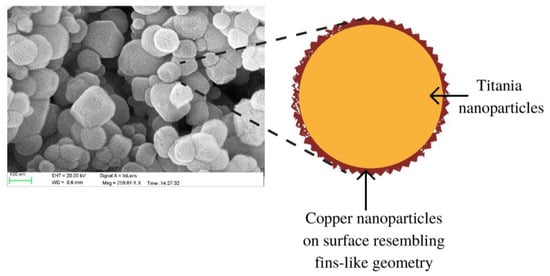
Figure 1.
Fin-like morphology of copper-titania nanoparticles. Adapted from [7].
Blended PCM nanocomposites reduce leakage. The tortuous structural paths incorporated by nanomaterial blending tether leakage of molten PCM. Sabagh et al. [10] investigated the characteristics of a polyethylene glycol (PEG), epoxy (EP), EG, and GO constituting composite. By stirring in the solvent, EG and GO were suspended in molten PCM for the preparation of the composite. The solvent was then evaporated by heating. At 70 °C, epoxy resin and curing agent were added. To make the composite, the produced mixture was molded and cured for 24 h at 30 °C and 4 h at 120 °C consecutively. The existence of cured epoxy’s capillary force, PEG-epoxy hydrogen bonding, and high surface area to volume ratio of EG inhibited PCM leakage above its melting point. PEG leakage is prevented by GO due to polymer chain entrapment between GO platelets, capillary force, and hydrogen bonding contact. The structure of the composite system is represented in Figure 2. Increasing the epoxy content of the sample reduces leakage by 43%. It also reduces normalized enthalpy, computed on the basis of the proportion of PCM in the composite, by 15%. This is due to greater encapsulation and reduced nucleation as epoxy concentration increases. Samples with a smaller proportion of epoxy, on the other hand, exhibited a 2% drop in normalized enthalpy. This sample’s leakage test revealed just 8% leakage as compared to pure PEG.
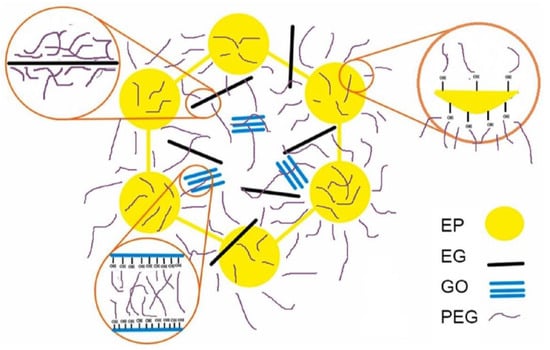
Figure 2.
Structure of PEG/EG/GO/EP composite system. Adapted from [10].
2.2. Microencapsulation
Nanoparticles can be blended with PCM to form the core of microcapsules. Long chain fatty acid-based PCMs suffer from supercooling problems. These organic PCMs have low thermal conductivity. Dhivya et al. [11] proposed a method for improving thermal characteristics of these PCMs. The research group formed an eutectic mixture of these PCMs for reducing the supercooling degree. The low thermal conductivity of PCMs was improved with incorporation of Ag-doped ZnO nanoparticles. The choice of substitution with Ag was made for preparing P-type conductive ZnO and achieving a synergistic surface plasmon effect. The ultrasonicated eutectic nanocomposite was further microencapsulated with melamine-formaldehyde (MF) shell by in situ polymerization. The 3–5 µm sized microcapsules could store 75–80 J/g heat. The method improved thermal conductivity of eutectic from 0.2513 W/mK to 0.3735 W/mK. The presence of shell and nanoparticles improved the thermal stability and thermal cycling performance of eutectic PCM. The sugar alcohols, erythritol, possess higher heat storage enthalpy than widely used paraffin wax and fatty acid-based PCMs. However, a high supercooling degree of about 100 °C is detrimental for its use in practical applications. Wang et al. [12] improved the supercooling characteristics of erythritol by 83.6% by preparing erythritol nanocomposites. The process of preparation involved two main steps. In the first step, an emulsion with the core content of erythritol and nucleating agent α-alumina nanoparticles was formed. The interface of the emulsion was adsorbed with polysiloxane precursor formed by hydration. In the second step, the polysiloxane precursor was polymerized with ultraviolet (UV) light for shell formation around the PCM core. The prepared microencapsulated PCM (MPCM) had a thermal conductivity of 0.84 W/mK, which was 29.2% more than erythritol. In MPCM, the crystal structure of PCM remained the same and gave a good latent heat storage capacity of 203 J/g. However, increased thermal conductivity improved crystallization kinetics. Thus, the heat release ratio of MPCM was 52.2% higher than erythritol. CNTs possess high thermal conductivity; however, in PCM-CNT blends, CNT agglomeration occurs. Such agglomeration concentrates high thermal conductivity in certain regions only. The poor dispersibility of CNT is due to its low compatibility and high density. Its dispersibility can be improved by grafting it with organic moiety. Meng et al. [13] grafted CNT with octadecyl isocyanate. The grafted CNTs were further blended with a mixture of two PCMs namely, octadecane and octacosane. The use of two PCMs assist in adjusting phase transition temperature range. The blend was further encapsulated with MF shell by the in-situ polymerization method. An addition of only 3% of grafted CNTs improved thermal conductivity by 71.4%.
Commercially used organic shell materials have low thermal conductivity and high pressure sensitivity. Inorganic materials have high thermal conductivity; they can be used as shell material to encapsulate PCM. Their high strength makes them suitable for practical applications. Zhang et al. [14] tested the suitability of CaCO3 shell for encapsulating PCM by the self-assembly method. The optimum level of stirring speed, temperature, and emulsifier concentration was determined to be 800 rpm, 45 °C, and 15 mmol/L, respectively. The core to shell ratio varied in amounts of half, one, two, three, and four, respectively. The optimized core:shell ratio was 3:1. Increasing the core content beyond this value produced agglomerated particles, as shown in Figure 3. Reducing the ratio below three produced rough shell surfaces. A very high concentration of shell catalyzed the formation of large CaCO3 crystals, which cannot encapsulate the core. This could lead to leakage of PCM. The FTIR, SEM, and transmission electron microscope (TEM) analysis confirmed the presence of CaCO3 shell for optimized formulation. XRD and differential scanning calorimetry calorimeter (DSC) analysis showed crystalline structure of MPCMs, which can store thermal energy. The MPCMs can store a latent heat of 134.83 J/g. Leakage test showed that the formation of CaCO3 shell form-stabilized PCM. The inorganic shell improved the thermal stability of PCM. It increased thermal conductivity to 0.542 W/mK from 0.152 W/mK. The mechanical strength of MPCMs was tested by stirring the MPCM dispersion at 2000 rpm for two hours. The particle size of stirred MPCMs remained the same. The SEM analysis observed roughness in shell structure. The heat storage enthalpy was reduced by 4% only. These results point toward the robustness of CaCO3 shell. Paraffin/graphene MPCMs were prepared by electrostatic self-assembly process [15]. The paraffin PCM was dispersed in water with stearic acid emulsifier by high speed homogenization. This dispersion was negatively charged. The graphene nanoparticles were dispersed with cetyltrimethylammonium bromide by ultrasonication. Under stirring, this positively charged dispersion was added dropwise to negatively charged paraffin dispersion. The electrostatic rearrangement in the mixture form graphene shell around the paraffin core. The wrinkled surface of MPCMs and smooth surface of paraffin in SEM images point towards core/shell structure formation. The characteristic peaks of paraffin appearing in MPCM structure confirmed microencapsulation.
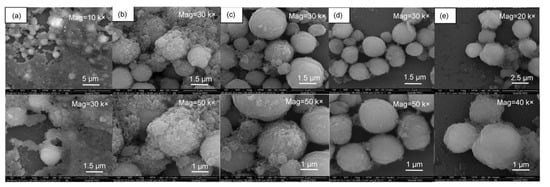
Figure 3.
SEM of MPCM with different core/shell ratios: (a) 0.5:1, (b) 1:1, (c) 2:1, (d) 3:1, (e) 4:1. Adapted from [14].
The inorganic shelled MPCM have good mechanical strength and high thermal conductivity. These MPCMs are often dispersed in organic polymeric matrices. Incompatibility between the inorganic shell and organic matrix can give anisotropic composite properties. To avoid this, a combination of inorganic and organic components can be used to encapsulate PCM. Zhao et al. [16] prepared a Pickering emulsion of paraffin wax with modified graphene particles. The Pickering emulsion was further encapsulated by the MF shell by in-situ polymerization. The synthesized MPCMs possess a light to thermal energy conversion property and high thermal conductivity of 0.707 W/mK. The combination of two nanoparticles can be used for preparing the Pickering emulsion. It can add properties of both nanoparticles as well as reduce the cost. Sun and Xiao [17] used polymethylmethacrylate (PMMA) organic shell and BN/TiO2 inorganic shell to encapsulate PCM. An aqueous phase of ultrasonicated nanoparticles dispersion and oil phase of PCM, PMMA precursor, and crosslinking agent were mixed. A stable Pickering emulsion was formed after mechanical homogenization. The prepared MPCMs possess a TES enthalpy of 124.4 J/g and thermal conductivity of 0.4215 W/mK. The hybrid shell possessed advantages of organic and inorganic components. The structural, morphological, and thermal characterization of MPCMs confirmed the effectiveness of the shell structure. Hussain and Kalaiselvam et al. [18] prepared a hybrid Ag2O-urea formaldehyde shell for microencapsulating oleic acid PCM. The in situ polymerization was performed with cationic, anionic, and nonionic surfactants. The cationic surfactant showed a better PCM encapsulation ratio over other surfactants. The Ag2O–urea formaldehyde shell formation over the surfactant stabilized core PCM particles further enhance the mechanical and thermal properties and the surface morphology. The presence of Ag2O particles can be confirmed from FTIR, XRD, and UV-visible absorption analysis.
2.3. Impregnation
The nanopores formed in the nanomaterial network can accumulate PCM by the impregnation method. The physical bonds formed between PCM and nanomaterial inhibit leakage of PCM. The impregnated PCM nanocomposites can be further coated with adhesive to avoid leakage. Ren et al. [19] vacuum impregnated paraffin wax into dried EG. The leakage-proof test of prepared nanocomposite proved 94% as the highest paraffin content for impregnating into porous EG. This nanocomposite requires structural support and protection from paraffin volatilization. Both aims were achieved by coating the optimized formulation of the nanocomposite tablet with epoxy adhesive. The optimized concentration ensured the prevention of epoxy adhesive in the pores of EG. Such passage of epoxy can increase thermal resistance of the nanocomposite. This would be detrimental to heat storage performance. Thus, the optimized concentration of PCM nanocomposite was coated with adhesive. The prepared nanocomposite can store 143.8 J/g of latent heat. Its thermal conductivity was improved to 2.141 W/mK. Zhang et al. [20] created macrocapsules of salt hydrate with the impregnation technique, as shown in Figure 4. Urea was transformed to a porous g-C3N4 structure by heating it to 550 °C at a rate of 5 °C per minute and then holding it at that temperature for 2 h. The resulting chemical, g-C3N4, was cooled to room temperature and ground. It had a pore diameter of 18.5 nm and a surface area of 50.35 m2/g. Salt Mg(NO3)2·6H2O was impregnated into porous g-C3N4 in a sealed flask in an oven at 95 °C for 3 h. After cooling, a cylinder with a diameter of 40 mm and a thickness of 10 mm was formed. It was wrapped in aluminum foil and sealed with epoxy resin. With the aid of its high surface area pores, the porous structure of g-C3N4 can integrate up to 80% PCM, provide moisture protection, and reduce subcooling from 29.2 °C to 1.9 °C. The second stage of coating with sealant preserves good TES characteristics, decreases weight loss, and prevents moisture from entering the macrocapsules after thermal cycling. This technique is inexpensive and allows the use of low-cost salt hydrate PCM with lower supercooling. Chin et al. [21] prepared porous oil palm kernel shell activated carbon from waste bioproduct. The porous structure was impregnated with paraffin wax. The structural stability and thermal conductivity of the impregnated composite were improved by a double coating of epoxy-nano alumina coat. The addition of 60% alumina nanoparticles in the epoxy resin improved the thermal conductivity of the epoxy by 271%. The thermal resistance associated with heat transfer through epoxy resin was minimized with alumina nanoparticles.
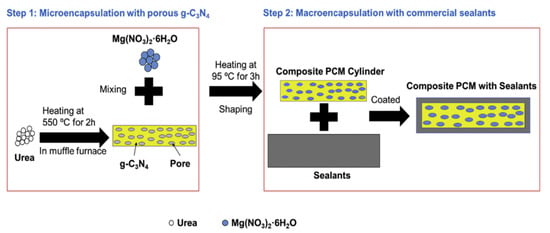
Figure 4.
Schematic diagram of the procedure to prepare Mg(NO3)2·6H2O/g-C3N4 composite. Adapted from [20].
The microporous foams can be synthesized in any dimension with good structural stability. This is not possible with other nanoporous materials, which require additional coating for structural stability. However, as compared to nanoporous materials, the microporous foam can hold a lesser amount of PCM without leakage. The leakage performance of microporous foams can be improved by adding nanoparticles. The high surface area and reactivity of nanoparticles tether the leakage of molten PCM. The synergistic effect of the combination of microporous material and nanoparticles improve shape stability. It can also add new material-specific properties to the composite. This concept has grabbed the attention of some research groups. Wang et al. [22] prepared flexible carbon foam (CF) percolated with Ti2O3 nanoparticles with the help of polydopamine (PDA). The good adhesion property of PDA is helpful for the conglutination of the Ti2O3/PDA network in CF. The Ti2O3/PDA network precoated with CF foam is a microporous substrate suitable for PCM impregnation. The lipophilic nature of PDA and capillary forces associated with Ti2O3 nanoparticles improved the leakage characteristics of CF foam. The maximum amount of PCM that can be incorporated in the prepared substrates is 84%. The prepared composite was bending-resilient, compression-resilient, and has photothermal conversion capability. These properties are induced because of the synergistic effect of composite components. Yang et al. [23] prepared a hybrid structure for impregnating PCM. The large pore size of graphene foam (GF) can incorporate a lesser amount of PCM without leakage. The covalent bonds present in GF improve phonon transport. On the other hand, graphene aerogel (GA) has a small pore size. It can incorporate a large amount of PCM without leakage. However, the physical crosslinks present in GA reduce the phonon transport rate and increase thermal resistance. Improved thermal properties and reduced leakage of PCM can be achieved by hybridizing GF and GA structures. Such a structure was obtained by self-assembly and the chemical vapour deposition technique. The formed hybrid microstructure was impregnated with paraffin wax, which improved thermal conductivity by 574%.
3. Applications
3.1. Building
Ren et al. [24] created a new electric TES concrete. The concrete was made with two porous supporting materials: ceramsite and pumice. The porous materials were dried and mixed with mixture of fatty acid PCMs and 7% graphene powder under magnetic stirring of 400 revolutions per minute (RPM) at 80 °C. For 60 min, the produced solution was vacuum impregnated in two porous matrices. After cooling, the aggregates were covered with epoxy resin as the first layer by soaking for 10 min. As a second layer, dry cement powder was applied onto epoxy resin. After that, the aggregates were immersed in water for three days. CNF is a superplasticizer dispersion in water produced with Hobart mixer by combining components for 5 min at 198 RPM. In a concrete mixer, this dispersion was mixed for two minutes with quartz sand and cement. Finally, macroencapsulated aggregate PCMs were added to the mixture and stirred for 1 min to prevent PCM leakage. The structure produced is given in Figure 5. The compressive strength of the concrete produced using this method is about 5 MPa. This material can be utilized to insulate buildings. The composites of ceramsite and pumice showed a reduction in temperature by 4.7 °C and 8.7 °C, respectively. This indicates that the pumice composite is more effective. Composites with enhanced electric conductivity can be utilized for electromagnetic shielding, health monitoring, and de-icing applications. The material’s dual characteristic of TES and high electrical conductivity make it attractive for future usage. Nanosilica impregnated with PCM pentadecane: to create core-shell structured macrocapsules, impregnated nanosilica was covered with an ethyl cellulose shell. These macrocapsules were then mixed with epoxy and a curing agent in a 1:1:0.024 ratio and cured. At 1.6 °C, the produced composite had a latent heat storage capacity of 43.1 J/g. Cui et al. [25] prepared PCM macrocapsules of two types. In the first type, PCM lauryl alcohol was vacuum impregnated in lightweight aggregates (LWA) and coated with two subsequent layers of epoxy resin. In the second type, after the same procedure of vacuum impregnation, the microcapsule was coated with cement paste consisting of 30 wt% epoxy. The encapsulation ratio of 49.1% was achieved in vacuum impregnation. Both types of macrocapsules incorporated in the concrete showed a good compressive strength of around 30 MPa. They showed minimal weight loss and enthalpy reduction after 150 thermal cycles. The author had calculated payback time of the material as 14 years, which is nearly one fourth of the total lifetime of buildings.
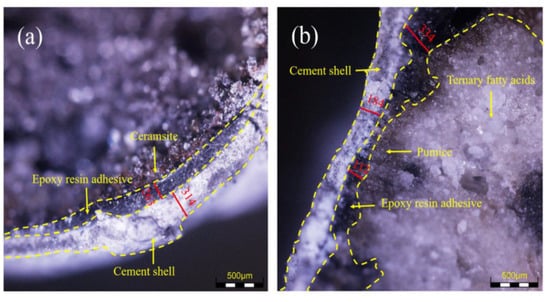
Figure 5.
Optical microscope images of encapsulation interfaces of (a) ceramsite-based aggregates and (b) pumice-based aggregates. Adapted from [24].
Mohseni et al. [26] created a latent heat storage aggregate (LHSA) that can be utilized in concrete formulations. LWA were impregnated with PCM using the vacuum impregnation procedure. These PCM macrocapsules were then chilled at 4 °C for 10 min before being covered with epoxy resin. On top of the epoxy coating, a second layer of silica fume was placed. The epoxy resin was allowed to set for seven days to prepare LHSA. To produce concrete, 50% LHSA was combined with LWA. Due to the high compatibility of fumed silica with other concrete components, concrete containing LHSA demonstrated a compressive strength of more than 30 MPa. It has a high TES and structural strength for 500 heat cycles, making it ideal for long-term performance in construction applications. Wang et al. [27] reported that epoxy–PCM composite modified concrete can retain temperatures within human comfort for double the time as compared to ordinary concrete. For preparing the composite with a phase change temperature range of 22–25 °C, liquid and solid paraffin were mixed in different proportions at 120 °C. The DSC analysis and time–temperature curve analysis of the mixed PCM 40:60 composition of liquid paraffin to solid paraffin was found suitable. This PCM composition was vacuum impregnated into ceramsite clay for 2 h at 60 °C. These impregnation parameters showed an impregnation ratio of 95.5%. The amount of PCM impregnated without vacuum was lower by 11.6%; thus, vacuum impregnation was chosen for further characterization. The ceramsite–PCM composite was sealed with cured epoxy polymer. Thermal cycling of the ceramsite–PCM composite sealed with epoxy in the temperature range of 10 to 40 °C reduced the leakage by 50%. The epoxy–PCM composite mixed with cement composite took 480 min to change temperature from 24 °C to 18 °C; regular cement composition took 240 min for the same temperature drop.
3.2. Solar Devices
Poyyamozhi and Karthikeyan [28] studied heat transfer performance of solar pond with PCM nanocomposites. The structure of the solar pond consisted of rectangular printed mild steel structure at the bottom with two holes for water passage. The upper part was covered with four triangular glass sheets forming a pyramid as shown in Figure 6. The heat transfer performance of the solar pond was observed for 30 min by incorporating PCM, PCM-AgTiO2, and PCM-CNT nanocomposites. The order of heat transfer in the solar pond was increasing in order as PCM < PCM-AgTiO2 < PCM-CNT. The corresponding maximum heat transfer temperatures were 49 °C, 53 °C, and 61 °C, respectively. The high thermal conductivity of CNT was the reason for better heat transfer performance of PCM-CNT nanocomposite. Tangsiriratana et al. [29] used MPCM coating to improve the performance of solar photovoltaic (PV) panels. The solar PV panels operate at high temperatures of around 60 °C. Their efficiency in the conversion of heat to electricity reduces with an increase in temperature. Thus, temperature reduction is important for improving the energy efficiency of PV panels; this can be done with PCM. The research group used abundantly available natural sugarcane wax as PCM, which has a melting temperature in the range of 77.6–80 °C. The thermal conductivity of wax improved by blending with Al2O3 nanoparticles. The blended wax was further microencapsulated in the gum-arabic shell by complex coacervation. The prepared MPCMs were coated on the backside of the PV panel with thicknesses 4 mm and 7 mm. The PV panel coated with higher thickness was found suitable for improving the energy generation efficiency of PV panel in an experimental study. It reduced the front panel part’s temperature by 4%. This temperature reduction improved power consumption by 12%. The increasing efforts of increasing the efficiency of solar power generation are essential for meeting future energy demands. This innovation has the potential to increase solar power generation to a larger extent. Yeh et al. [30] prepared a compact solar water heater. The energy efficiency of the device was improved by incorporating shape stabilized PCM-EG formulation and optimizing the geometry of the device. The optimization studies succeeded in improving the heat discharging period by 2.6 times. Effective utilization of solar energy for heating water was achieved with thermally conductive PCM formulation. The high temperature cooking methods require solar parabolic dish concentrator instruments at outdoor facilities. This instrument could also lead to health injuries in the form of sunburns and eye damage. Bhave and Kale [31] prepared a cooking vessel incorporated with solar salt PCM. This vessel can be charged with heat on a clear sunny day. The heat-charged vessel was kept in a heat-insulated chamber until the time of actual cooking. The heat charging method with PCM allows the user to choose the time and place of cooking the food. Unlike other solar instruments, the food can be cooked in a closed facility as well as at night time. This method gives a uniform cooking temperature. This instrument can fry 0.25 kg of potato chips in 17 min. It can cook rice in 20 min. Sunburn can be avoided while using non-conventional, green energy from the sun.
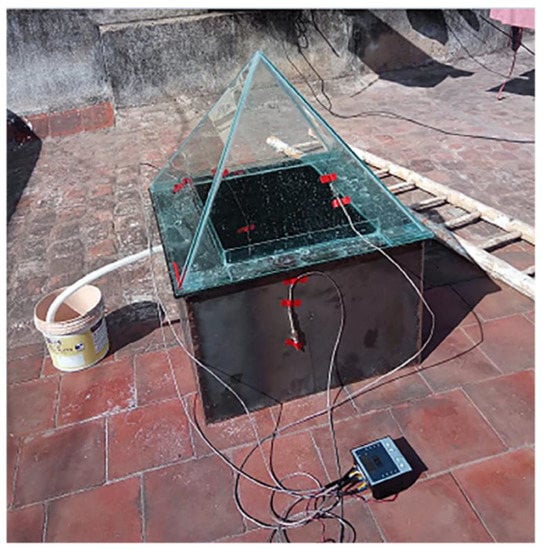
Figure 6.
Arrangement of solar pond. Adapted from [28].
3.3. Electronic
The present trend of compacting the structure of electronic components and improving heat dissipation rate can be fulfilled with PCM incorporation. Often PCM is incorporated as a separate entity in addition to the main structural component of electronic assembly. Fredi et al. [32] prepared a multifunctional composite. This composite was made by blending paraffin wax with CNTs. The blend was further encapsulated into the 3D epoxy structure by the moulding process. The inorganic CNT fillers improved the mechanical, thermal, and electrical properties of the composite. The low electrical resistivity value of 1.2 × 103 Ω·cm of the prepared composite makes it a potential candidate for electrically conductive multifunctional composites. Atinafu et al. [33] prepared a paraffin nanocomposite for manufacturing electro-thermal devices. The nanocomposite possessed synergistic properties of exfoliated graphene nanoplatelets and CNTs. The π–π interaction within graphene nanoplatelets and agglomeration of CNTs adversely affect the morphology and functional properties of nanocomposites prepared by blending only one kind of nanoparticles. The introduction of two kinds of nanoparticles in PCM help in forming homogeneous 3D structure. This structure supported heat and electron transfer at a faster rate. It reduced the electrical resistivity of PCM by six times. The reduced supercooling, improved PCM loading percentage, and increased latent heat storing capacity of the hybrid nanocomposite proved useful for transferring heat from electronic components. Kalaiselvan et al. [34] prepared a nanoencapsulated PCM suitable for cooling electronic chips as well as electrode material. The encapsulation process involved nanoencapsulation of oleic acid-PEG eutectic mixture with a primary shell of SiO2 and secondary shell of SnO2 material. The secondary shell helped in reducing PCM leakage and ensured functional properties to nanoencapsulated PCM. SnO2 is an n-type semiconductor known for its high electron transport rate. Owing to this property, the prepared nanocapsules possessed a high electrical conductivity of 1.08 × 10−7 S/cm. They can also be used for storing electrochemical energy.
3.4. Textiles
PCM incorporated in clothing controls heat release in response to temperature change. It helps the body’s thermoregulation mechanism by maintaining constant temperature. PCM-incorporated textiles often use PCM in smaller quantity for optimizing other essential properties such as breathability, bending rigidity, etc. The efficacy of heat transfer in the available PCM amount can be improved by incorporating thermally conductive nanoparticles. However, the health hazard associated while handling additive nanoparticles imposes the use of modified manufacturing facilities and a skilled labour force. These conditions limit the use of nanoparticles on a larger scale. Many research groups have strived to develop ways of synthesizing in situ nanoparticles while processing PCMs. The in situ nanoparticle preparation process helps in minimizing handling problems. Rezaie and Montazer [35] prepared thermoregulating textile coatings by the direct-use method. The coating composition was prepared with an eutectic PCM mixture of fatty acids. The eutectic mixture gives the opportunity to alter thermal characteristics such as phase change temperature range and phase change enthalpy. The thermal conductivity of coating composition was improved by in situ preparation of copper nanoparticles. The coating was applied on a polyester (PET) fabric sheet. The chemical structure of the coating is shown in Figure 7. The nanoparticles diffused in the PCM eutectic mixture improved the thermal conductivity by 100.1%. The leakage characteristics and chemical resistance of PCM composite were improved with a protective outer layer of vinyl-acrylate resin. The coated samples underwent a phase transition process in the temperature range of 29–37 °C, which is suitable for body temperature regulating textiles. The incorporation of copper nanoparticles improved the tensile strength of the fabric, but it also increased its rigidity. Thus, optimizing both parameters while achieving maximum heat storage is crucial for textile clothing applications.
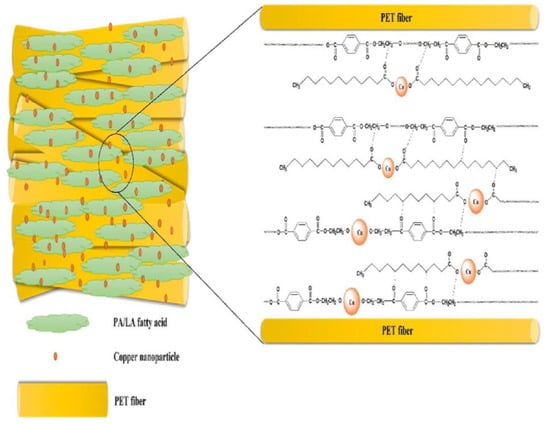
Figure 7.
Schematic of incorporation of copper nanoparticles into PCM applied on the polyester fiber. Adapted from [35].
A PCM/polymer core/sheath structure can be obtained by coaxial electrospinning with a core component of PCM and a shell component of polymer [36]. This morphology hinders leakage of PCM. However, the limitations of optimizing flow rates of core and shell spinning solutions and requirement of structural modification for the electrospinning device make the coaxial spinning process cumbersome. On the other hand, the single phase electrospinning method is simple. However, it requires a spinning solution composed of compatible materials. The presence of nanoparticles ensured better interaction of nanoparticles with other components of the spinning solution. Thus, single phase electrospinning is found to be successful for spinning nanofibers containing nanoparticles. Salimian et al. [37] identified a simple and green technique for synthesizing PCM nanofibers. The components of nanofibers were PEG PCM, PVA polymeric support, silver, and TiO2 nanoparticles. TiO2 nanoparticles bonded with the functional groups of PVA and PEG, as shown in Figure 8. In heat and sunlight, such structures crosslinks to form (TiO2)m(OH)n. The silver ions were formed from an AgNO3 solution. The silver ions react with the hydroxyl groups of activated TiO2, PVA, and PEG. This interaction resulted in silver nanoparticles generation, which are stabilized into the matrix. The nanofibers were spun from a solution containing these constituents by a single phase electrospinning machine. The compatibility between the constituents resulted in form-stabilized, uniform fibre morphology. Thus, commonly used organic solvents and complex coaxial electrospinning mechanisms can be avoided for obtaining electrospun fibres. The electrospun fibres can be used in textile applications. The nanomaterial incorporated in fibers gives their special characteristics to the final product. For example, TiO2 incorporated PCM-nanofibers possess UV shielding and thermoregulation [38]. Both these properties are desirable for smart textile manufacturing. These nanofibers ensure good TES property for over 500 heat-cool cycles. This ensures the longevity of the heat storage function.
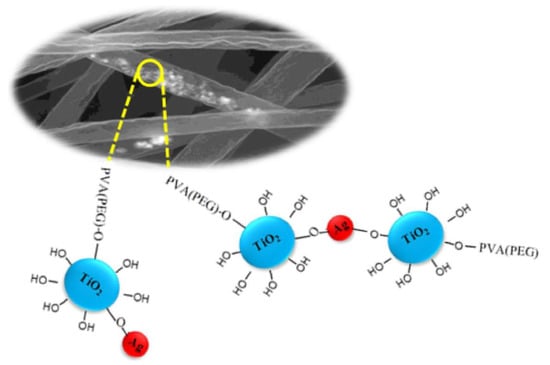
Figure 8.
Structure of PVA/PEG/Ag/TiO2 nanofibers. Adapted from [37].
3.5. State-of-the-Art Applications
Luo et al. [39] produced a thermally conductive epoxy-PCM nanocomposite with shape memory characteristics. The nanocomposite was made by changing the PEG content as well as the thermally conductive additive boron nitride (BN) content in the physical blending process with epoxy resin. Shape memory function is caused by the covalent-non-covalent interpenetrating polymer network (IPN). The shape memory and TES characteristics were conferred to the composite at about 80 °C due to the unique structural architecture. In epoxy–BN composite, BN caused amorphous PEG to crystallize. This phenomenon was confirmed by the SEM picture. As a result, the enthalpy of nanocomposite was raised over its theoretical value. Crystalline PEG serves as a transient phase while IPN serves as the permanent phase following heat treatment. The prepared composites have high TES capacity and shape memory characteristics and may be employed in various applications. Infrared detection technology is used in the military field to detect foreign objects. The energy difference between foreign objects and the background depends on minimizing temperature difference. The IR image is captured with this energy difference. Infrared stealth performance depends on minimizing this energy difference. A PCM coating on foreign objects could help in minimizing temperature difference. Many researchers have used the principle of lowering surface emissivity for improving infrared stealth performance by incorporating conductive metals and polymers. Gu et al. [40] used the synergistic effect of PCM and conductive polymer polyaniline (PANI) to prepare infrared stealth polyester fabric. They prepared double shelled MPCM with a primary shell of melamine-urea-formaldehyde and secondary shell of PANI. The MPCMs were further coated on polyester fabric with waterborne polyurethane coating. The coating thickness of 1.354 mm showed an infrared stealth performance with 0.794 emissivity and temperature reduction of 11.2 °C for 27 min. Li et al. [41] prepared UV-shielding MPCMs with TiO2 doped silk fibroin shell. The nanoparticles absorb inorganic UV rays. The core and shell MPCM give TES and UV absorption, respectively. Lou et al. [42] prepared MPCM to shield gamma radiation actuated from nuclear devices. They prepared lead tungstate embedded MPCM shells by self-assembly method. The high thermal conductivity of PbWO4 improved the heat storage performance of MPCMs.
4. Conclusions
PCMs are well known for their TES property. The TES benefits applications ranging from building materials, textiles, electronic systems, solar energy storage devices, etc. However, low thermal conductivity of PCMs is disadvantageous for heat transfer. Researchers found that thermally conductive nanoparticles could improve PCM performance. The continuous development in this direction helped researchers to incorporate multifunctional nanoparticles in PCMs. Such nanoparticles not only help in TES but also impart application-oriented properties to PCMs. Researchers explored synthesis routes of PCM nanocomposites by blending, microencapsulation, and impregnation methods. Blending is a simple technique of preparing PCM nanocomposites for large-scale applications. High nanoparticle loading is required to shape-stabilize PCM-nanocomposite. Adding PCM in a polymer matrix with low nanoparticle loading can also shape-stabilize PCM. This can lower PCM’s heat storage enthalpy. Polymers bring desirable qualities into nanocomposite, which are advantageous for application. However, shear forces exerted by the polymer interfere with PCM–nanoparticle interaction during the phase transition process. These counteracting factors should be optimized as per application requirements. The PCM nanocomposite structure is constructed on microlevels using the microencapsulation process. During the phase transition process, this approach shields PCM from external contact. Its preparation cost is greater, and thus it is suitable for specialized applications where small quantity is required. The impregnation technique is suitable for preparing PCM nanocomposites in large-scale applications. Blending PCM impregnated particles into other material reduces the mechanical strength of the final product; thus, it is ideal for applications requiring a small amount of PCM. Most of the research studies affirmed the improvement in the thermal characteristics of PCM with the addition of nanoparticles, although the outcomes of some studies were inconsistent. The reason for these conflicting results was the poor dispersion of nanoparticles. Further research is required to examine the dispersion and settling of nanoparticles in PCM to develop a consensus on the effect of nanoparticles.
Author Contributions
Writing—original draft preparation, T.A.; writing—review and editing, P.M. All authors have read and agreed to the published version of the manuscript.
Funding
This work is funded by AICTE National Doctoral Fellowship Scheme sanctioned vide letter F No.: 12-2/2019-U1 provided by the Ministry of Human Resource Development, Government of India.
Institutional Review Board Statement
Not applicable.
Informed Consent Statement
Not applicable.
Acknowledgments
The authors acknowledge library facilities provided by Institute of Chemical Technology, Mumbai in accessing research databases.
Conflicts of Interest
The authors declare no conflict of interest.
References
- Amberkar, T.; Mahanwar, P. Manufacturing Technology of Shape-Stabilized Phase Change Materials. Int. J. Res. Rev. 2018, 5, 24–34. [Google Scholar]
- Amberkar, T.; Mahanwar, P. Review on Thermal Energy Storing Phase Change Material-Polymer Composites in Packaging Applications. Mater. Proc. 2021, 7, 14. [Google Scholar] [CrossRef]
- Pielichowska, K.; Pielichowski, K. Phase change materials for thermal energy storage. Prog. Mater. Sci. 2014, 65, 67–123. [Google Scholar] [CrossRef]
- Jegadheeswaran, S.; Sundaramahalingam, A.; Pohekar, S.D. High-conductivity nanomaterials for enhancing thermal performance of latent heat thermal energy storage systems. J. Therm. Anal. Calorim. 2019, 138, 1137–1166. [Google Scholar] [CrossRef]
- Elarem, R.; Alqahtani, T.; Mellouli, S.; El Awadi, G.A.; Algarni, S.; Kolsi, L. Experimental investigations on thermophysical properties of nano-enhanced phase change materials for thermal energy storage applications. Alex. Eng. J. 2022, 61, 7037–7044. [Google Scholar] [CrossRef]
- Aurangzeb, M.; Noor, F.; Qamar, A.; Shah, A.N.; Kumam, P.; Shah, Z.; Shutaywi, M. Investigation of enhancement in the thermal response of phase change materials through nano powders. Case Stud. Therm. Eng. 2022, 29, 101654. [Google Scholar] [CrossRef]
- Suresh Kumar, K.R.; Parameshwaran, R.; Kalaiselvam, S. Preparation and characterization of hybrid nanocomposite embedded organic methyl ester as phase change material. Sol. Energy Mater. Sol. Cells 2017, 171, 148–160. [Google Scholar] [CrossRef]
- Bose, P.; Amirtham, V.A. Effect of titania-silver nanocomposite particle concentration and thermal cycling on characteristics of sodium dodecyl sulfate added paraffin wax thermal energy storage material. Energy Storage 2021, 3, 4–6. [Google Scholar] [CrossRef]
- Vaka, M.; Walvekar, R.; Khalid, M.; Jagadish, P.; Low, J.H. Corrosion, rheology, and thermal ageing behaviour of the eutectic salt-based graphene hybrid nanofluid for high-temperature TES applications. J. Mol. Liq. 2021, 334, 116156. [Google Scholar] [CrossRef]
- Sabagh, S.; Bahramian, A.R.; Madadi, M.H. Improvement in phase-change hybrid nanocomposites material based on polyethylene glycol/epoxy/graphene for thermal protection systems. Iran. Polym. J. (Engl. Ed.) 2020, 29, 161–169. [Google Scholar] [CrossRef]
- Dhivya, S.; Hussain, S.I.; Jeya Sheela, S.; Kalaiselvam, S. Experimental study on microcapsules of Ag doped ZnO nanomaterials enhanced Oleic-Myristic acid eutectic PCM for thermal energy storage. Thermochim. Acta 2019, 671, 70–82. [Google Scholar] [CrossRef]
- Wang, Y.; Li, S.; Zhang, T.; Zhang, D.; Ji, H. Supercooling suppression and thermal behavior improvement of erythritol as phase change material for thermal energy storage. Sol. Energy Mater. Sol. Cells 2017, 171, 60–71. [Google Scholar] [CrossRef]
- Meng, X.; Qin, S.; Fan, H.; Huang, Z.; Hong, J.; Xu, X.; Ouyang, X.; Chen, D.Z. Long alkyl chain-grafted carbon nanotube-decorated binary-core phase-change microcapsules for heat energy storage: Synthesis and thermal properties. Sol. Energy Mater. Sol. Cells 2020, 212, 110589. [Google Scholar] [CrossRef]
- Zhang, Q.; Liu, C.; Rao, Z. Preparation and Characterization of n-Nonadecane/CaCO3 Microencapsulated Phase Change Material for Thermal Energy Storage. ChemistrySelect 2019, 4, 8482–8492. [Google Scholar] [CrossRef]
- Deng, H.; Guo, Y.; He, F.; Yang, Z.; Fan, J.; He, R.; Zhang, K.; Yang, W. Paraffin@graphene/silicon rubber form-stable phase change materials for thermal energy storage. Fuller. Nanotub. Carbon Nanostruct. 2019, 27, 626–631. [Google Scholar] [CrossRef]
- Zhao, Q.; He, F.; Zhang, Q.; Fan, J.; He, R.; Zhang, K.; Yan, H.; Yang, W. Microencapsulated phase change materials based on graphene Pickering emulsion for light-to-thermal energy conversion and management. Sol. Energy Mater. Sol. Cells 2019, 203, 110204. [Google Scholar] [CrossRef]
- Sun, N.; Xiao, Z. Synthesis and Performances of Phase Change Materials Microcapsules with a Polymer/BN/TiO2 Hybrid Shell for Thermal Energy Storage. Energy Fuels 2017, 31, 10186–10195. [Google Scholar] [CrossRef]
- Hussain, S.I.; Kalaiselvam, S. Nanoencapsulation of oleic acid phase change material with Ag2O nanoparticles-based urea formaldehyde shell for building thermal energy storage. J. Therm. Anal. Calorim. 2020, 140, 133–147. [Google Scholar] [CrossRef]
- Ren, X.; Shen, H.; Yang, Y.; Yang, J. Study on the properties of a novel shape-stable epoxy resin sealed expanded graphite/paraffin composite PCM and its application in buildings. Phase Transit. 2019, 92, 581–594. [Google Scholar] [CrossRef]
- Zhang, W.; Zhang, Y.; Ling, Z.; Fang, X.; Zhang, Z. Microinfiltration of Mg(NO3)2·6H2O into g-C3N4 and macroencapsulation with commercial sealants: A two-step method to enhance the thermal stability of inorganic composite phase change materials. Appl. Energy 2019, 253, 113540. [Google Scholar] [CrossRef]
- Chin, C.O.; Yang, X.; Paul, S.C.; Susilawati; Wong, L.S.; Kong, S.Y. Development of thermal energy storage lightweight concrete using paraffin-oil palm kernel shell-activated carbon composite. J. Clean. Prod. 2020, 261, 121227. [Google Scholar] [CrossRef]
- Wang, W.; Cai, Y.; Du, M.; Hou, X.; Liu, J.; Ke, H.; Wei, Q. Ultralight and Flexible Carbon Foam-Based Phase Change Composites with High Latent-Heat Capacity and Photothermal Conversion Capability. ACS Appl. Mater. Interfaces 2019, 11, 31997–32007. [Google Scholar] [CrossRef] [PubMed]
- Yang, J.; Qi, G.Q.; Bao, R.Y.; Yi, K.; Li, M.; Peng, L.; Cai, Z.; Yang, M.B.; Wei, D.; Yang, W. Hybridizing graphene aerogel into three-dimensional graphene foam for high-performance composite phase change materials. Energy Storage Mater. 2018, 13, 88–95. [Google Scholar] [CrossRef]
- Ren, M.; Liu, Y.; Gao, X. Incorporation of phase change material and carbon nanofibers into lightweight aggregate concrete for thermal energy regulation in buildings. Energy 2020, 197, 117262. [Google Scholar] [CrossRef]
- Cui, H.; Memon, S.A.; Liu, R. Development, mechanical properties and numerical simulation of macro encapsulated thermal energy storage concrete. Energy Build. 2015, 96, 162–174. [Google Scholar] [CrossRef]
- Mohseni, E.; Tang, W.; Wang, S. Development of thermal energy storage lightweight structural cementitious composites by means of macro-encapsulated PCM. Constr. Build. Mater. 2019, 225, 182–195. [Google Scholar] [CrossRef]
- Wang, Q.; Zhang, C.B.; Ding, Z.Y.; Liu, J. Study on the thermal properties of paraffin/ceramsite phase change concerte. Adv. Mater. Res. 2014, 838, 91–95. [Google Scholar] [CrossRef]
- Poyyamozhi, N.; Karthikeyan, A. Performance comparison of AgTiO2 and CNT based latent heat materials on a solar pond. Mater. Today Proc. 2021, 47, 4548–4551. [Google Scholar] [CrossRef]
- Tangsiriratana, E.; Skolpap, W.; Patterson, R.J.; Sriprapha, K. Thermal properties and behavior of microencapsulated sugarcane wax phase change material. Heliyon 2019, 5, e02184. [Google Scholar] [CrossRef] [Green Version]
- Yeh, C.Y.; Boonk, K.J.F.; Sadeghi, G.; Mehrali, M.; Shahi, M.; Brem, G.; Mahmoudi, A. Experimental and numerical analysis of thermal performance of shape stabilized PCM in a solar thermal collector. Case Stud. Therm. Eng. 2022, 30, 101706. [Google Scholar] [CrossRef]
- Bhave, A.G.; Kale, C.K. Development of a thermal storage type solar cooker for high temperature cooking using solar salt. Sol. Energy Mater. Sol. Cells 2020, 208, 110394. [Google Scholar] [CrossRef]
- Fredi, G.; Dorigato, A.; Fambri, L.; Pegoretti, A. Wax confinement with carbon nanotubes for phase changing epoxy blends. Polymers 2017, 9, 405. [Google Scholar] [CrossRef] [PubMed] [Green Version]
- Atinafu, D.G.; Yun, B.Y.; Kang, Y.; Wi, S.; Kim, S. Three-dimensional hybrid carbon nanocomposite-based intelligent composite phase change material with leakage resistance, low electrical resistivity, and high latent heat. J. Ind. Eng. Chem. 2021, 98, 435–443. [Google Scholar] [CrossRef]
- Hussain, S.I.; Roseline, A.A.; Kalaiselvam, S. Bifunctional nanoencapsulated eutectic phase change material core with SiO2/SnO2 nanosphere shell for thermal and electrical energy storage. Mater. Des. 2018, 154, 291–301. [Google Scholar] [CrossRef]
- Rezaie, A.B.; Montazer, M. In situ incorporation and loading of copper nanoparticles into a palmitic–lauric phase-change material on polyester fibers. J. Appl. Polym. Sci. 2019, 136, 46951. [Google Scholar] [CrossRef]
- Rezaei, B.; Askari, M.; Shoushtari, A.M.; Malek, R.A.M. The effect of diameter on the thermal properties of the modeled shape-stabilized phase change nanofibers (PCNs). J. Therm. Anal. Calorim. 2014, 118, 1619–1629. [Google Scholar] [CrossRef]
- Salimian, S.; Montazer, M.; Rashidi, A.S.; Soleimani, N.; Bashiri Rezaie, A. PCM nanofibrous composites based on PEG/PVA incorporated by TiO2/Ag nanoparticles for thermal energy management. J. Appl. Polym. Sci. 2021, 138, 51357. [Google Scholar] [CrossRef]
- Wang, J.; Xu, J.; He, Y. Novel smart textile with ultraviolet shielding and thermo-regulation fabricated via electrospinning. J. Energy Storage 2021, 42, 103094. [Google Scholar] [CrossRef]
- Luo, F.; Yan, P.P.; Qian, Q.; Li, H.; Huang, B.; Chen, Q.; Wu, K.; Lu, M. Highly thermally conductive phase change composites for thermal energy storage featuring shape memory. Compos. Part A Appl. Sci. Manuf. 2020, 129, 105706. [Google Scholar] [CrossRef]
- Gu, J.; Wang, W.; Yu, D. Temperature control and low infrared emissivity double-shell phase change microcapsules and their application in infrared stealth fabric. Prog. Org. Coat. 2021, 159, 106439. [Google Scholar] [CrossRef]
- Li, Y.; Zhao, L.; Wang, H.; Li, B. Microencapsulated -octadecane with TiO2-doped silk fibroin shell for thermal energy storage and UV-shielding. J. Phys. Chem. Solids 2019, 134, 97–104. [Google Scholar] [CrossRef]
- Lou, L.; Jiang, Z.; Zhang, Q.; Liu, D.; Zhou, Y.; Zhang, K.; He, R.; Fan, J.; Yan, H.; Yang, W. Phase change microcapsules with lead tungstate shell for gamma radiation shielding and thermal energy storage. Int. J. Energy Res. 2019, 43, 8398–8409. [Google Scholar] [CrossRef]
Publisher’s Note: MDPI stays neutral with regard to jurisdictional claims in published maps and institutional affiliations. |
© 2022 by the authors. Licensee MDPI, Basel, Switzerland. This article is an open access article distributed under the terms and conditions of the Creative Commons Attribution (CC BY) license (https://creativecommons.org/licenses/by/4.0/).